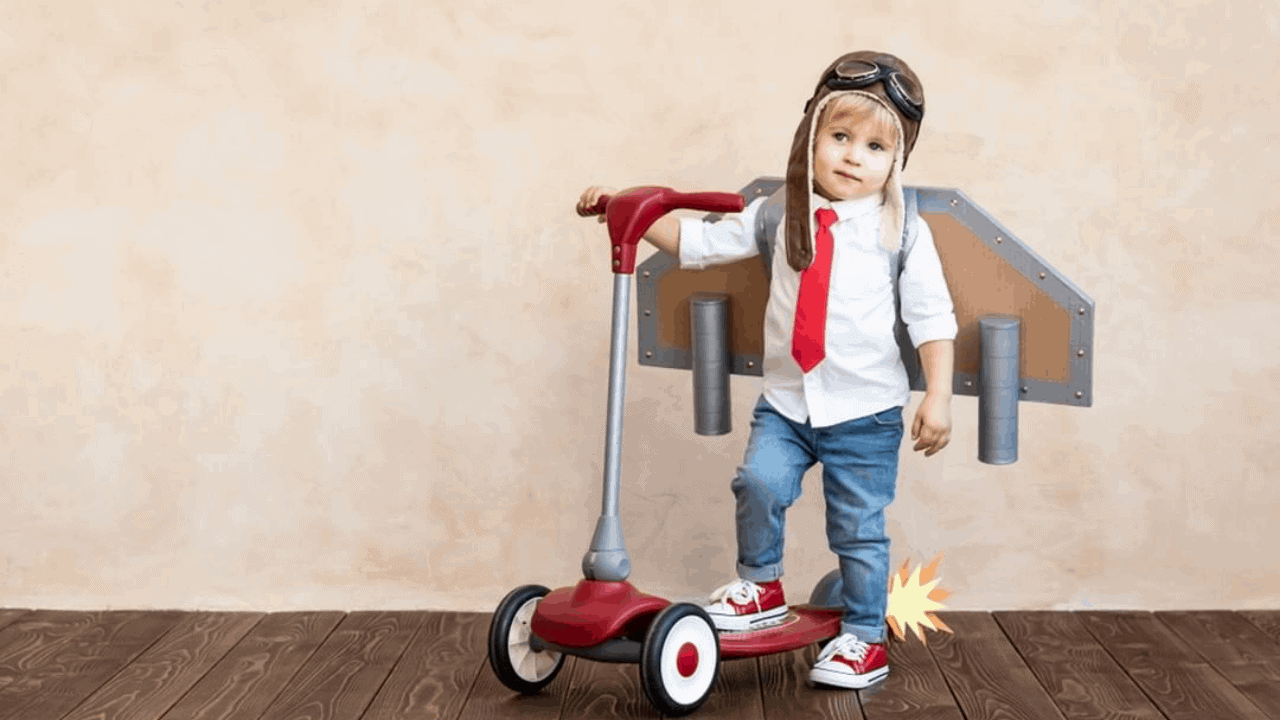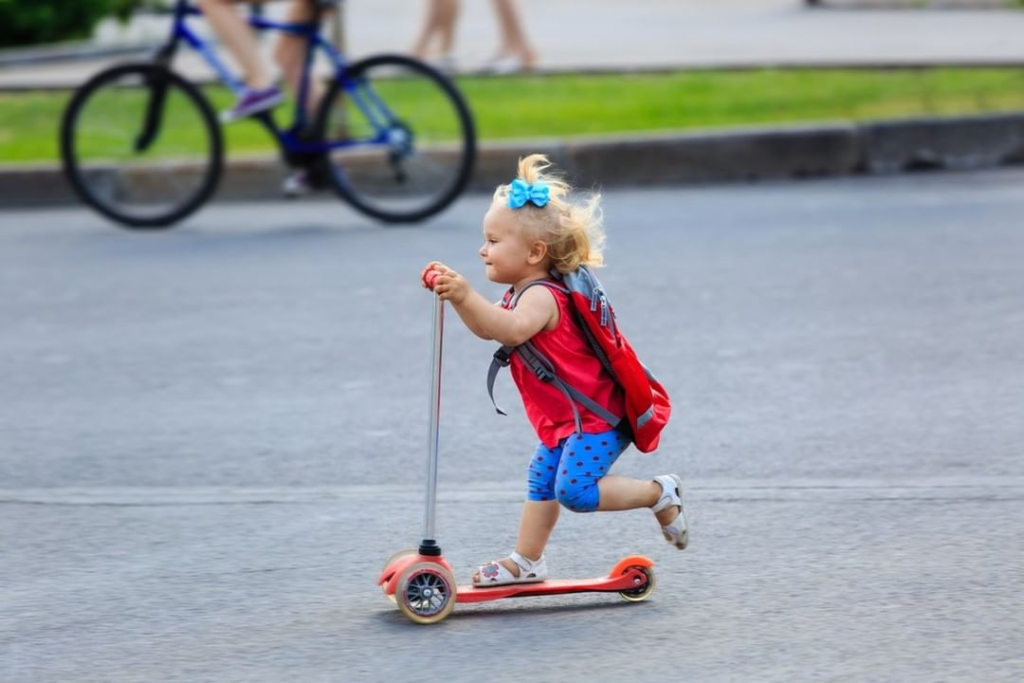What is the Appropriate Age for a Scooter? Posted in: Kids Scooters – Tags: what age do kids ride scooters

Children enjoy anything that makes them feel as a “grown-up.” And the thrill of controlling a scooter or ride-on toys serves just that. The demand for scooters has been on the increase, and it’s important to know what’s in the market. While the pleasure from thrilling rides is a top priority in your kid’s list, safety should remain in yours.
These toys require a relatively developed sense of balance, coordination, and bodily competency. Thus the emphasis on your child meeting a few criteria in order to qualify to become a scooter owner.
With freedom comes responsibility, and you must choose the appropriate scooter for your child’s age. Once your child can walk, they should be able to mobilize a motor with relative ease.
The trouble, as a parent, now comes with choosing the right scooter that’s age-appropriate. Features ranging from balance to speed mean that consumers raise the safety question of these mobility toys. Parents require scooters that minimize the risk of injury and accidents as their kids explore their new freedom.
So before picking that scooter for a gift, consider these important factors that’ll make it safe for your kids. These recommendations are made based on the level of maturity of the child and their behavior. Concerning the scooter itself, certain features may be beyond the scope of a particular age group.
Because most of these scooters are self-pedaling, it’s crucial to ascertain whether the scooter is suitable for their age. The following characteristics are a good starting point when considering purchasing a scooter:
- Level of Motor Skills Needed
- Body Dimensions of Scooter
- Reasoning Maturity
- Licensing (where it applies)
1st Consideration: Are They Old Enough to Ride A Scooter?

Once your child is able to walk independently and maintain stable balance, then they’re likely to be ready for one. Age may not be definitive as children develop at different rates. Therefore, considering the child’s physical capabilities will be more telling than mere age. Different age groups will have different requirements that will be reflected in the choice of the scooter.
Toddlers
Infants this young won’t be able to keep up with the jostling of scooter riding. A sustainable sense of balance hasn’t developed at this stage, and so riding a scooter won’t be possible. A ride-on that allows an adult to ride along with them is recommendable. To curb any fights from your toddler feeling excluded, you may invest in such options. That way, you can all enjoy some family time, and you can keep your eyes on your toddler.
The adult controls the motor while the toddler sits separately. Most of these can be converted once their owners are grown into separate scooters.
2 to 3 Years Old
Though development differs, for most, these have a steady gait and, for the most part, can manage without adult interference. However, they may still lack the cognitive maturity to ride self-pedaling scooters with complete freedom. The steering skill required to dodge objects may not have developed fully and result in accidents.
Electric scooters at this stage are a tad bit too advanced. Comprehension plays a big part in a child’s ability to perform, and so self-pedaling scooters are advised. These toys should be low enough for the user to climb on and off with ease. Adult supervision is still necessary since a minor mistake with foot placement may result in an accident.
4 to 5 Years Old
Balance and coordination at this age are better developed, and upgrades to battery-operated scooters can be made. Though physical abilities have improved, their level of curiosity here necessitates constant supervision. They may try risky tricks like speeding and so oversight to ensure their safety at all times is essential.
As they begin to explore more, the adults responsible should ensure that the kids know how to maneuver their scooters. Skills like steering, turning, and braking should be emphasized. Honing necessary skills ensures that no harm comes to them, even if they ride off without guidance.
6 to 8 Years Old
If they’ve been riding since they were an infant, then by now, they’ve grasped most of the skills needed to control a scooter. If they’re only starting, that’s also alright. By this age, they’ve matured enough to be able to handle a scooter on their own, even at the first attempt. For first-timer riders, care may still be needed until the minor’s confidence is gained.
After that, while teaching riding skill mastery, it’s essential also to prioritize responsibility. Kids here are old enough to understand what is at risk if rules are not followed. Their skillset may allow them to be upgraded to fancier equipment.
10 Years Old and Up
At this point, your child is already an experienced rider. Now, they may focus more on advanced riding skills and, thus, need scooters that suit their needs. Adjustable ones that can “grow” with them are best so that they last longer. They are significantly taller and more substantial at this age, and adjustments to accommodate such need to be attended to.
Nearing teenage-hood, they may now see themselves as “adults” and have more input when buying the scooter. While considering their preferences, safety is still key.
2nd Consideration: Scooter Features

From the variation in the number of wheels to the speed and quality of the parts, there’s a lot to look at. Shifting the focus from the rider to the actual machinery takes even more complex scrutiny.
Speed
Parents have a choice to make between the kick-type and the battery-operated type. For the novice riders, it’s better to stick to the self-pedaling options. Besides affordability, they’re generally more comfortable to maneuver and have a limited velocity range. For the older kids, however, speed is where the thrill lies, and so they may need electric alternatives.
Anything below 10 mph is generally acceptable for minors, and above eight, this becomes negotiable.
Balance
Here, your options are vast. From three-wheel scooters with variations of 2:1 and 1:2 front-rear types to two-wheeled options. Generally, the three-wheel options are best for younger riders. These are perfect for growing your child’s confidence in themselves as they learn to ride.
Because older kids need less support, their alternatives allow more intricate designs to be incorporated. Two-wheel scooters are only advisable for more mature kids who have better stamina and experience.
Wheel Size
Wheel size, more often than not, correlates with the scooter deck size. These range from small, medium, large, and very large. Small wheeled self-pedaling ones can carry a weight of up to 100kg. The discrimination lies within the handlebar size. Small ones are very portable and, depending on the intended use of the scooter, are very good. Their added advantage is their greater agility.
More substantial wheels require more force to start and stop. Therefore, they’re not great for younger kids, despite their higher stability. Their larger frame, however, means that the rider is limited in their colorful skill display.
Scooter Size
A more obvious decision to make is the scooter size. The scooter will need to be able to fit the rider comfortably, regardless of skill level. Say, for example, your child only started riding at the age of ten. Their experience may dictate that they ride with the infants, but their size is more important. In this case, getting one with adjustable bars is advisable.
Getting a more advanced scooter, far beyond your child’s experience, may endanger your child. This is why acquiring the appropriate one, size-wise, as well as know-how, is critical.
Wrapping It Up
It’s important to remember that these are just guidelines. Taking into account the respective child’s growth rate will play a crucial role in decision making. Being present as your child rides also makes it easier for you to identify their skill sets. This, in turn, will help both of you when making a purchase.
At whatever age, your offspring starts riding; however, always take care that they use their helmets. This guarantees that, though preliminary measures to minimize accidents are made, they’re safe if something unforeseen happens.